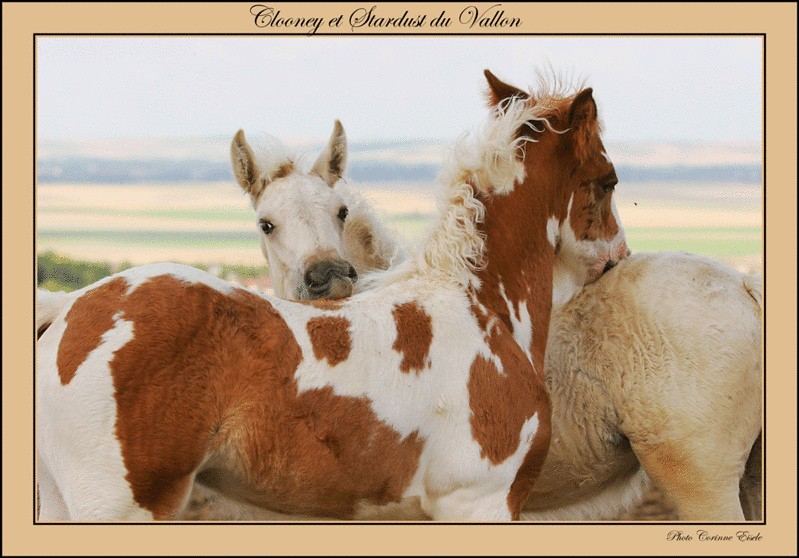#Irish vanner
Text
Pleasantly surprised Breyer's new premium release refers to the breed as just the Vanner and says Irish and Romani Travellers! Hopefully this pushes the renaming movement further

#for context the breed is often called a slur for romani peoples so there's been a somewhat recent push to instead call it#the Vanner#or Irish Cob#breyer
136 notes
·
View notes
Text
#OTD in Irish History | 18 April:
1608 – Sir Cahir O’Doherty of Inishowen revolted and sacked Derry.
1689 – Siege of Derry began. In 1688, James II, a Catholic, was deposed by his Protestant daughter, Mary, and her husband, William of Orange, in a bloodless coup known as the Glorious Revolution. James fled to France and in 1689 landed in Ireland, hoping to incite his Catholic supporters there and regain the British throne. Aided…

View On WordPress
#irelandinspires#irishhistory#OTD#18 April#Gypsy Vanner Horse#History#History of Ireland#Ireland#Irish Civil War#Irish History#Northern Ireland#RTÉ#Today in Irish History
8 notes
·
View notes
Text

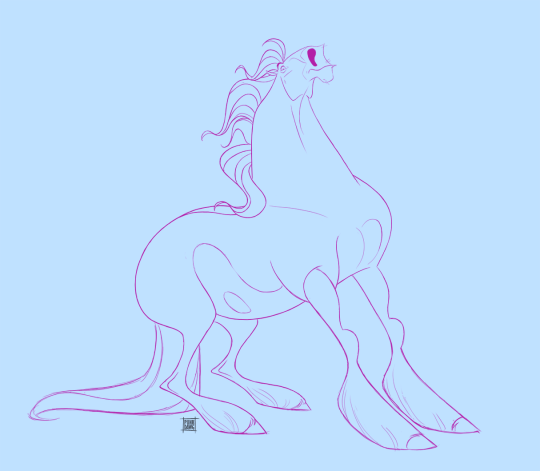



Missed drawing horses.
Here are some steps too, this one was really fun to sketch.
#irish cob#digital art#character design#horse#pony#gypsy vanner#gypsy cob#cob#tinker#draft horse#my art#dream horse
35 notes
·
View notes
Text
van der linde gang as horse breeds
i love drawing horses so i decided to draw all 24 of the rdr2 gang members as horses. i tried to tie the breed or coat to their character in some way (personality or looks) but some were purely random. i don't really explain my reasoning in this post because i am tired but comment or flick me an ask if you want me to explain.

Dutch - Cremello Thoroughbred
Hosea - Bay Clydesdale
Arthur - Buckskin Quarter Horse
John - Grulla Blanket Appaloosa
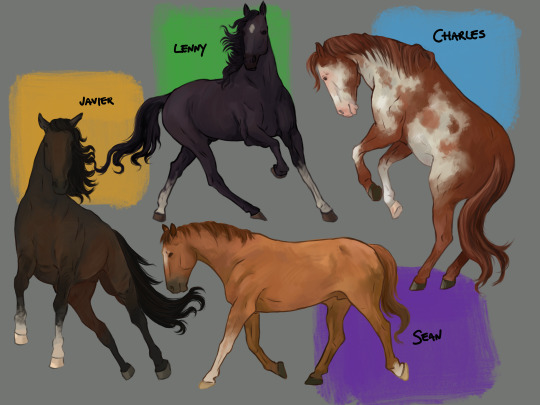
Charles - Brown Overo American Paint Horse
Sean - Chestnut Irish Draught
Lenny - Black Tennessee Walking Horse
Javier - Dark Bay Andalusian

Sadie - Palomino Mustang
Karen - Rose Gray Hanoverian
Tilly - Sooty Buckskin Morgan Horse
Mary-Beth - Black Friesian
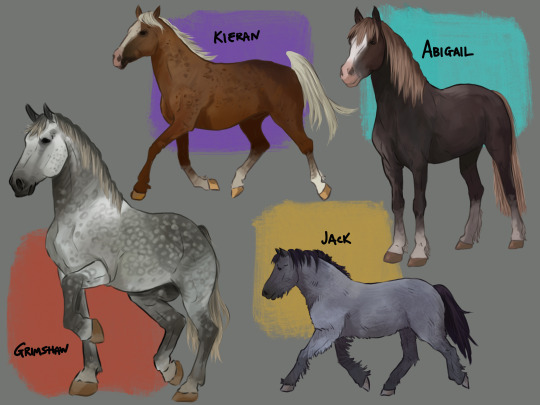
Abigail - Liver Chestnut Flaxen Welsh Cob
Jack - Blue Roan Dartmoor Pony
Kieran - Chocolate Palomino Connemara Pony
Grimshaw - Dappled Grey Percheron

Bill - Red Roan Belgian Draft
Uncle - Gray Donkey
Pearson - Sorrel Sufflock Punch
Strauss - White Lipizzan
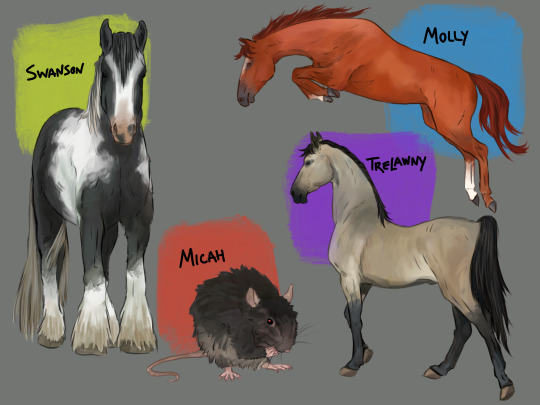
Molly - Red Chestnut Selle Francais
Trelawny - Silver Buckskin American saddlebred
Swanson - Piebald Gypsy Vanner
Micah - rat (pretty self explanatory)
13 hours later and it's done yay!! if you'd like to support me my ko-fi is linked on my profile and i also have commissions open. please enjoy and pray for my posture. i think i might continue this series but with a general animal theme instead of just horses.
73 notes
·
View notes
Text
Found proof other Tennessee walker/Irish cob crosses exist

Found this guy on random website is the only horse found labeled Tennessee walking horse and gypsy vanner cross saw old forum talking about my cross but no pictures there.
5 notes
·
View notes
Text
Horse Breed Tournament
Round 4 Group 1
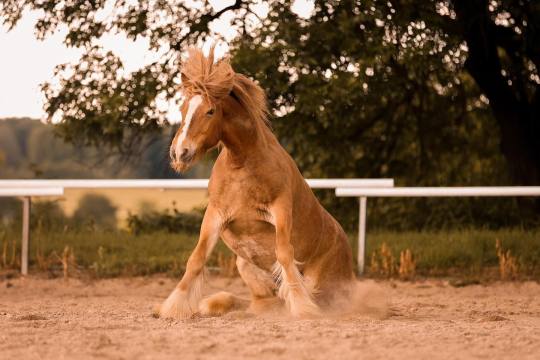
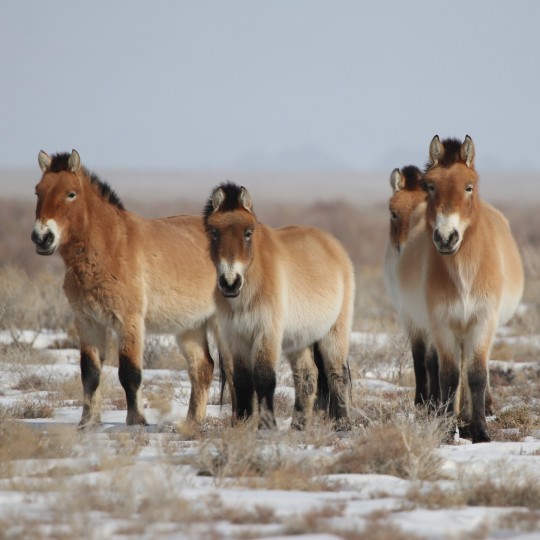
Gypsy Horse Image by _sannisun_ (Instagram) --- Przewalski Image by internationaltakhigroup (Instagram)
5 notes
·
View notes
Photo
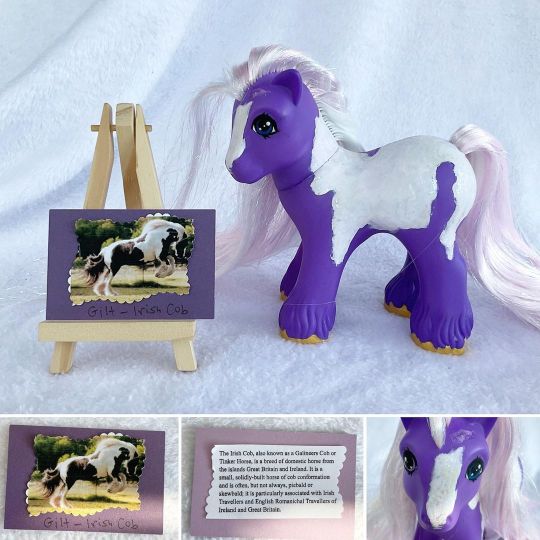
Today is the final pony of the What If pony rainbow, Gilt the Irish Cob! I’ve always wanted to make a brightly colored pinto, and I ended up making a purple piebald instead! 🤣 This handsome lad is based on a horse I’ve often seen called a Welsh Cob or Vanner, but all of the references online called them Irish Cobs! I added some glitter to the edges of his white markings to brighten them up, and he has heterochromic eyes - lavender and blue! I love his blaze which trails down into his little lip markings, and his gold hooves! Those were super fun to add! ✨ Gilt is created from a white @hqg1c bait that I dyed! #ponygurucustom #mylittleponyfair #ponyfairwest #mylittlepony #mylittleponycustom #mlp #mylittleponybigbrother #purple #mylittleponycustomizer #hqg1c #customtoy #mylittleponyg1 #mlpg1 #mylittleponyfair2022 https://www.instagram.com/p/Cidx_-cJgYR/?igshid=NGJjMDIxMWI=
#ponygurucustom#mylittleponyfair#ponyfairwest#mylittlepony#mylittleponycustom#mlp#mylittleponybigbrother#purple#mylittleponycustomizer#hqg1c#customtoy#mylittleponyg1#mlpg1#mylittleponyfair2022
18 notes
·
View notes
Text
Notes from The Tale of Prince Steven of Avalon

OKAY so I decided that instead of going back and editing this fic's notes and risking nobody seeing the relevant info that I desperately want to share, I'd stick it here! (I'm calling it the Ficcyclopedia™.) SO! If you have any interest at all in the inner workings of my brain in regards to this fic, it's all below the cut. 💜
In the first chapter, these are the relevant tidbits, neatly sorted because my OCD said to.
Places:
The original fairy tale takes place in Ireland, and I kept that the same, save for the name of the kingdom. Avalon is a play on the land Tír na nÓg, which is the mystical "otherworld" in Irish mythology. Avalon is just another name for "paradise" or afterlife, basically. I wanted something pronounceable, so this happened. It also is really fitting with Steve's character (both in this story and in MCU canon), in my opinion.
I basically decided to run with the whole "Bucky is probably Jewish" Fanon thing, and decided his mother was possibly (in my head most likely) from Poland. Thus, a lot of locations and names and things stemmed from Polish culture and mythology. So, bouncing off of the whole "Avalon-is-based-on-Irish-afterlife" thing, I named Bucky's homeland Verais (Vehr-eye) as the phonological equivalent of Wyraj, which is the afterlife in Polish mythology. And yes, it is spelled a little prettier than just phonetics, because I said so.
In conjunction with the Verais thing, I named the people there the Lechian people, which is for Lechia, an ancient name for Poland.
"The Land of Ice" is a pretty obvious (to me) way of saying Russia.
Gidra is Russian for Hydra. Do with that what you will. ;)
Names/Creatures:
The name Drew means "from druids" which is a play on the fact that in the original story of Conn-Eda, the prince's stepmother was the daughter of a druid. I wanted to include that little thing, even if it wasn't exactly the same.
His last name, Balcombe, means "person who casts an evil eye." It's also a surname that's common to the Isle of Man, which is the place I based Drew's homeland off of.
In the original fairy tale, the supernatural hound is called Samer. Samer means lots of different things in many languages, but my favorite was the Sanskrit for "air" or "wind." I turned it kind of Polish and gave the hound the name Zenon, which is derived from the Greek god Zeus. And Zeus, as we know, is the god of the skies or whatever. ;P This one is a bit more convoluted, but I think it still works.
Even though "Alkonost" seems like a made-up word, IT'S NOT!!! It's the English pronunciation of Алконост. The Alkonost is a woman-headed bird in Russian mythology. And the creature that Conn-Eda goes to see in the original fairy tale is a bird with the face of a human. This one took me ages to find, but I did it for you guys. :D (JK I really did it for me, but y'all benefit, so.) (Also, in chapter two, I made the Alkonost a man. I know it's not perfectly in line with the mythology, but it's really important to me that it be a guy, okay? You'll see why.)
Almaz is the English pronunciation of алмаз, which means "diamond." I wanted the stone Alexander gives Steve to be something precious, but also Russian, because reasons.
Movyatzekon is a semi-made-up word for talking horse, strung together from the words "talking" and "horse" in Polish.
In a related vein, the horse breed that I imagine Bucky is is called a Gypsy Vanner. I picked it because it has famously shaggy hair (and so does Bucky at certain points in Marvel canon!!). The very specific horse I envision for Bucky is in the moodboard above.
Misc. Stuff:
Mulct is an actual word!! It means "a fine, or compulsory payment." Basically, it's the punishment Steve gets for losing the challenge his stepfather gives him.
Variola is an ancient name for smallpox. I chose this as the disease Steve's dad dies from in the fairy tale because, canonically, he dies from mustard gas exposure. Mustard gas exposure can cause skin lesions that can mimic the look of smallpox.
And chapter two stuff, which is literally only places:
Steve and Bucky pass through a kingdom called Albion, which is a very ancient name for England (going back as far as 5th century B.C.E.). Guess where on the map I imagine it is? Yes, you're right. It's England. ;D
They also pass through a land called Veneti, which is named for an ancient west-Slavic tribe called Veneti. It's meant to be where Belarus is, roughly.
Chapter three stuff, which is one measly thing:
(in reference to the chapter title) Travail: painful or laborious effort
If you want to talk about where certain MCU characters come into play, you can always scream at me in whatever way you want! I am probably disproportionately excited about how I've managed to work in so many MCU characters in general, so it's a whole thing in my brain now.
And if you read all the way to the bottom of this long-ass post, thank you and I love you. I mean, I'll love y'all regardless of whether you read the post, but yeah. ✌🏻
#Raven rambles#The Tale of Prince Steven of Avalon#as seen on ao3#you can click the moodboard to get to the story if you wanna#I feel like I am so fucking awkward for posting this ngl#but I'm doing it anyway#Stucky fic#my writing#fan fiction#I'll just go before I start rambling in the tags too
2 notes
·
View notes
Note
Hello :) my favourite horse is the irish cob, would these be the same as the gypsy vanner or are they related breeds?
you know I almost immediately answered this but then I google imaged it and realized what I in America think and Irish Cob is may be different than what an Irish Cob is considered in the UK (could be like how Belgians in Europe are an entirely different breed than Belgians in the US).
Because when I think Irish Cob, I think of this, which I realize now may just be an Irish Draught:
But in Ireland it seems like the Irish Cob is this:
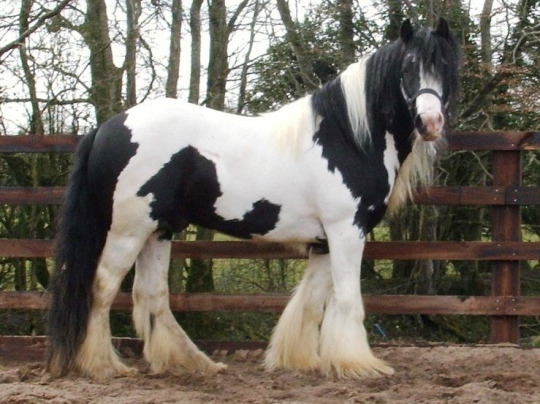
which looks very similar to a Gypsy Vanner/Tinker horse! So it could just be a matter of different countries calling the same horse breed two different things. I know it has Romani origin (I think that's why people are pushing to use "Tinker" and not "Gypsy" Vanner, though people still mostly use Gypsy Vanner), so it would make sense that it comes from the UK.
What's funny is that Tinker horses are insanely expensive in the US for pretty much no reason outside of "Pretty!" while in the UK they're just considered your average kid's horse or horses used by the Romani to get around. I think they'd consider Americans crazy for paying $10k for one lol.
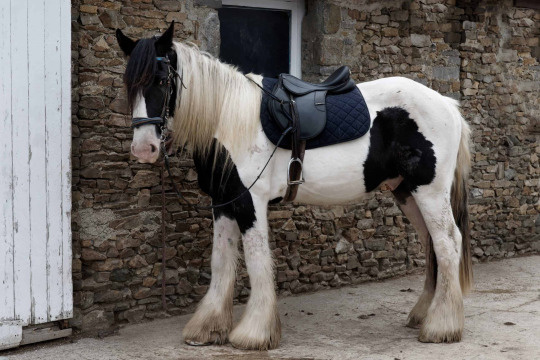
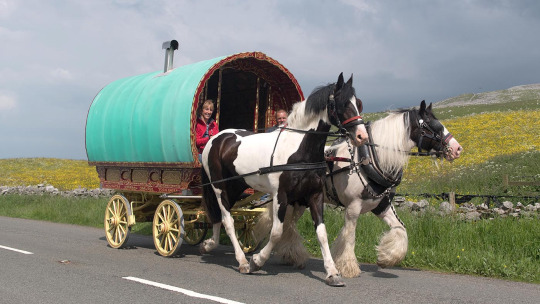
1 note
·
View note
Video
Friendly Foals by Melody
Via Flickr:
French kisses. Stardust is the palomino. Clooney is her painted red boyfriend! Photo by Corinne.
#horse#foal#foals#palomino#colt#filly#chestnut#gypsy#tinker#romany#irish cob#vanner#cob#pair#two#love#www.domaineduvallon.com#Corinne Eisele#Stardust#Clooney#NOT PHOTOGRAPHED BY ME#flickr
64 notes
·
View notes
Note
717712803103997952 I hope to fucking god it's not the one that looks like a goddamn horse and was changed to "Irish Cob" instead of "Gypsy Vanner." GYPSY VANNER IS A TYPE OF FUCKING HORSE. people are so fucking sensitive holy shit!! if you have the time and energy to be offended by every single little thing, then GET A HOBBY. A REAL ONE. OR A JOB.
.
0 notes
Photo

New Post has been published on https://horsetoloan.com/horse-breeds/gypsy-horse-breed-gypsy-vanner/
Gypsy Horse Breed Gypsy Vanner

Gypsy Horse Breed – The Gypsy Vanner
The Gypsy horse, or the Gypsy Vanner, is a breed of horse that hails from Great Britain and Ireland. They are recognizable for their white splashes and were bred and used by the Irish Travelers as well as the English Romanichal Travelers.
This is what gave the breed their name! Gypsy Vanners were often— and still are— used to pull the traditional vardos, or wagons, of the Romani subgroup in the English Isles.
This is a fairly newer breed, especially when compared to some other breeds of horses that have been around for centuries. We will go over the Gypsy Vanner horse in more detail below, including its characteristics and history.
Gypsy Vanner Characteristics
When it comes to the defining characteristics of a Gypsy Vanner horse, they are most often piebald or skewbald colored. In addition, they have the conformation of a cob. The Gypsy Vanner is also called the Irish Cob, and are classified as being small draught horses because of their strong hindquarters. Gypsy horses have a flowing mane and tail and feathered legs, as well as having a general appearance of a heavy, powerful horse. The head of a Gypsy Vanner is sweet, which means it is without coarseness in proportion and fits the overall balance of the horse. Their bite should also be even.
Gypsy Vanner Size
The Gypsy Vanner breed stands at a height of between 13 and 15.2 hands high. However, these rules are not very strict, as the Gypsy Horse Association will accept heights outside of the aforementioned range, meaning that horses both smaller and larger may be accepted. When compared to other breeds of horse, the Gypsy Vanner height is considered to be average.
Among draft horses, this breed is considered to be small, especially when you take into account that the Shire horse can stand up to 18 hands in height! The Irish Cob, or Gypsy Vanner, is a horse characterized by a sturdy, broad, and compact body. They have dense bones and deep, powerful chests. The chest of the horse should show off ample muscles.
Gypsy Vanner Weight
Weight is not restricted by the Gypsy Horse Association for registrations. However, the breed does have an average weight, of course, and that average is between 1100 and 1700 pounds.
There are many registries across the globe for the Gypsy Vanner breed, and all accept different heights— this means that there is also a big weight range for Gypsy Vanner horses, as height and weight are proportionately linked in horses.
This is a breed that has dense bones, too, which therefore makes them heavier than the average light horse breed. The strong muscles and conformation of the Gypsy Vanner makes the breed heavy cob-type horses.

Gypsy Vanner Colors
Like with weight, the Gypsy Horse Association is not picky with colors, either. They accept all colors and markings of the Gypsy Vanner breed. There is even an old saying in the breed standard that is often mentioned by the registry.
It goes as follows: “A good horse never comes in a bad color”. Thus, the Gypsy Vanner is not a color breed, as some other breeds of horses are. They can be diverse in color, though there are some colorations or patterns that occur more often.
These most common colorations are piebald and skewbald. Both of these are characterized by white patches on dark coats, which is typical of Gypsy Vanners. Rarer colors that you may see the breed appear in are champagne, cremello, and palomino. They may be solid, tobiano, or splash-in patterns.
Gypsy Vanner Temperament
The Gypsy Vanner is a breed beloved for its temperament, too, and not just its many colors. They are well known for being kind and tolerant, as well as patient and intelligent. They have an agreeable nature which makes them a fantastic family horses. They can also be used as therapy horses due to their unflappable personality.
In addition to all of these characteristics, the breed is known for being tractable, sensible, and willing. A good Gypsy Vanner will have all of these important traits. These traits also make the Gypsy Vanner an adaptable breed that is able to participate in all of the equine disciplines. You could see a Gypsy Vanner in dressage, jumping, driving, and more!
Gypsy Vanner Care
If you give your horse the proper care and maintenance that it needs, it will be able to live a long and happy life. The Gypsy Vanner breed, for example, can live an average of 20 to 25 years if properly taken care of. It is also important to note that this is a breed that does have several care needs. The weight and the feathers of the horse are what needs the most care and attention, typically. That being said, the Gypsy Vanner is still considered to be an easy keeper among horses. We will go over the needs of the Gypsy Vanner in greater detail further in this article.
Gypsy Vanner Diet and Nutrition
Some horses have very demanding diets, while the dietary needs of other breeds are less so. As each breed of horse has a different build, energy level, purpose, and more, not all breeds will benefit from the same diet. The Gypsy Vanner breed is one that is a less demanding eater, especially when it comes to things like supplements.
They do need a bit more forage than the average horse, which is because of their conformation and weight. Horses of this breed will also need a variety of fresh hay, pasture, some grains and vegetables, and some fruits, too.
Draft horses, such as the Gypsy Vanner, are known to have economical metabolisms. This means that they are able to digest nutrients slowly and more efficiently. Draft horses can also be prone to obesity, which means that their grazing should be monitored carefully to avoid this.
Gypsy Vanner Health Issues
Like every breed of horse, there are some common health issues that can crop up with the Gypsy Vanner breed. That being said, this breed is overall a pretty healthy horse breed. The Gypsy Horse Association even notes that they are a sturdy and healthy breed. Hardy breeding has made Gypsy Vanners a breed that is good at jumping and swimming and is even able to carry heavy weights on its back.
They have strong conformations and can withstand many obstacles. However, one of the biggest health issues to be aware of is obesity. This is a health problem common with all draft breeds.
To avoid this, you should not overfeed your Gypsy Vanner and should also maintain a healthy diet. Gypsy Vanners can be prone to polysaccharide storage myopathy, or PSSM, and equine metabolic syndrome, or EMS, as well.
Gypsy Vanner Grooming
While the Gypsy Vanner horse does not have a particularly demanding diet, as we went over above, the required grooming of this breed is certainly more involved. One factor is the feathers on the horse’s legs. They are striking, but they do require more upkeep to avoid issues such as skin irritation or diseases. Most, but not all, of the Gypsy Vanner horses will have feathers.
Their feathers must be washed and dried every 3 to 4 days. If you do not do so, your horse may end up dealing with skin irritation or skin infections. In addition to caring for your horse’s feathers, you will also want to brush its coat every day with a body brush in order to remove any small particles or debris. A curry comb should also be used to get rid of more serious grease and dirt as well as to stimulate your horse’s blood flow.
Gypsy Vanner History
The Gypsy Vanner breed has not been around for very long, especially when compared to other breeds. Because of this, they do not have as much of a lengthy history. These small draft horses were used and developed by the English Romanichal and Irish Travelers. Below, we will go over the history of the Gypsy Vanner horse as we know it today.
Gypsy Vanner Origin
As we mentioned above, the Gypsy Vanner is a breed that originated in the British Isle and was used by the English Romanichal and Irish Travelers so that they could better travel through the Isles. However, the horses were not used by travelers until the later 19th century. Once they began to use the Gypsy Vanner horse, they used them to pull their vardos, or caravans, and then started to breed the horses to better fulfill this purpose. They bred the Gypsy Vanner horse to be the ideal caravan horse, using the Shire, Clydesdale, and British ponies such as the Dales to crossbreed for favorable traits.
Gypsy Vanner Historic Development
After World War II, the English Romanichal had the ambition and vision to create what they pictured to be the perfect caravan horse. This horse would be “a small Shire, with more feather, more color, and a sweeter head”, and this is what the original breeding goal was. Most of the steps of the selective breeding process were not documented to the outside world. It was not until two Americans by the names of Dennis and Cindy Thompson were traveling through the English countryside and came upon a breed of horse that was not known to them, grazing in the fields. The Thompsons went on to assist in creating the breed now known as the Gypsy Vanner. They did this by connecting with the English Romanichal and being the first to take the first of horses across the pond to the United States. The breed is still more common in Europe where they originated than in North America.
Notable Gypsy Vanner Horses
Gypsy Vanner horses were not known to the outside world for a long time, as we mentioned previously. This means that there was less time for horses of the breed to become notorious or famous. However, there are still some famous Gypsy Vanner horses that are worth mentioning! These horses have typically won competitions or hold records. Some Gypsy Vanner pedigrees are also notable as they have produced well-known horses.
The Gypsy King
The Gypsy King is a famous Gypsy Vanner horse who is a black and white tobiano stallion. He was famous for being the sire of 84 foals. He was also the first of the Gypsy Vanner stallions that the Thompsons imported to the United States, back in 1998. The Gypsy King is widely considered to be the most famous and recognized of the Gypsy Vanner breed, all over the world.
Birthday Boy King
Birthday Boy King was a Gypsy Vanner who was born on Cindy Thompson’s birthday. He is a striking black Blagdon stallion and lives at the Appleby equestrian center. He is also recognizable for the prominent blaze on his forehead, three stockings, and a sock. Birthday Boy King’s sire is The Gypsy King, another famous Gypsy Vanner horse. This means he is directly descended from the first Gypsy Vanner to step foot on US soil.
VV King William
VV William was a black and white tobiano stallion. He was born in 2007 and is 15 hands tall at his withers. He has sired approximately 35 foals, and his own sire was the legendary Gypsy Vanner stallion The Gypsy King! In addition, VV William has fathered many champion offspring. These champs include the likes of the Champion and Hall of Fame Stallion GG Lyuba’s King Zeus.
Gypsy Vanner Myths and Legends
Like with the history of the Gypsy Vanner and the notable horses of the breed, we do not know as much about Gypsy Vanner myths and legends, because they are still a fairly new breed of horse.
They were unknown to the outside world for quite a while. The legends that surround the breed mainly originate from the English Romanichal community. We will go over some of the details of the stories and myths that we do know further in this article.
Verbal History
It was not until the late 19th century that the first studbook of the breed was introduced. Instead, the breeding goals and the history of the Gypsy Vanner was passed down verbally in the English Romanichal and Irish Traveler communities. This is one of the main reasons that we do not know about the older history of the breed.
Ireland, not Great Britain
The Gypsy Vanner is a horse of many names, which can be confusing to some. For example, the breed is also known as the Irish Cob. There is a reason for this, though! The Gypsy Vanner originated from Ireland and not the UK, which is why the breed has these names. The Gypsy Vanner is the more commonly used name for the breed in the United States.
Fairytale Horse
The Gypsy Vanner, or Irish Cob, is a breed that looks particularly magical! On top of its magical appearance, there are also some beliefs that the breed is not just an ordinary horse. Locals in Ireland used to believe that these horses have a connection to fairies and leprechauns, and some do still believe this! The horses are also called Tinker Horses, and of course, we all know the fairy Tinkerbell of Peter Pan fame. Do you believe in magic, too?
Modern Gypsy Vanner Horses
The Gypsy Vanner was unknown for many years, and the outside world had no idea that they existed. These days, though, the breed has emerged to worldwide popularity. They are beloved for their temperament and unique appearance, too.
That being said, they are still a fairly rare breed. Gypsy Vanners can especially be found in the United Kingdom, Ireland, and the United States, often being used as family horses or pleasure horses. The kind temperament of the breed and solid conformation has made the Gypsy Vanner popular, and thus their breeding has increased in volume in past years.
Gypsy Vanner Breeding
The Irish Cob, or Gypsy Vanner, breed of horse began to grow in popularity in the United States. This, of course, was due to the interest of the Thompsons in the breed. The Gypsy Vanner has also increased its popularity in the breed’s home countries of the United Kingdom and Ireland. They are more common than ever and can now be spotted all over the countryside!
Due to the sweet and kind nature of the Gypsy Vanner, many families have a gelding of the breed on their farm or keep them as family pets. Most of those that own Gypsy Vanners these days are not nomadic, as the travelers who originally bred them are. Th Gypsy Horse Association still remains the original breeding goal of the English Romanichal.
Gypsy Vanner Population
As we have mentioned earlier in this article, the Gypsy Vanner is a fairly rare breed of horse, though it has become more common in recent years. It is estimated that there are around 10,000 horses of the breed across the globe today.
Of these 10,000 horses, 20% of them are selectively bred so that they can maintain the Gypsy Vanner breed standards. While there are not definitive numbers about the Gypsy Vanner population, it is estimated that 20% of the horses reside in the United States. Of course, the number of Gypsy Vanners is low in comparison to the number of some more populous breeds like the American Quarter Horse. This low number can be attributed to the relative newness of the Gypsy Vanner breed.
Gypsy Vanner Uses
The Gypsy Vanner is a particularly versatile breed, as according to the Gypsy Horse Association. In fact, they even say that the Gypsy Vanner or Irish Cob is “beyond doubt, the most versatile of animals in existence and long ago established a reputation as the best ride and drive animal in the world”. The gait of this breed is agile, powerful, and well-balanced.
All of this makes them successful dressage horses. Another trait of the breed is that they have a good depth of body and are suited for driving or riding. After all, the breed was used for pulling caravans, originally. Their kind temperament makes them good for any use. They are also naturally gifted jumpers and can even compete in jumping and dressage as a result.
Gypsy Vanner Prices
The price of a horse is commonly thought to be the purchase price, and while this is true, there are other costs associated with a horse as well. While there are different purchase prices for a horse depending upon certain characteristics, there are also additional costs that you will continue to pay for your horse’s lifetime. These include the cost of food and room and board, for example. Below, we will go over some of the numbers associated with owning a Gypsy Vanner horse.
Gypsy Vanner Purchase Price
The Gypsy Vanner horse can be more expensive than more common and popular breeds like the Thoroughbred or American Quarter Horse. Part of the reason for this is because of the low number of Gypsy Vanner breeders in the United States.
It is a classic case of supply and demand driving the cost up! The breed was only imported into North America a couple of decades ago, so the number of available horses is limited, therefore increasing the purchase price. On average, a Gypsy Vanner stallion will cost between $1200 to $25,000. A Gypsy foal, on the other hand, can cost as low as $120 if you were to purchase it in Ireland, where the breed is more populous.
Then, you would have to factor in import costs with the purchase price. Import costs to the states, for example, can be up to $7,500. A good Gypsy Vanner horse can cost between $3400 to $5400 on average, while a very high-quality Gypsy Vanner can cost around $25,000.
Some of the things that come into play here are how old the horse is and how well it is trained. Bloodlines are also important and can drive up the purchase price of a horse. For example, if the horse comes from champions, it will cost much more than a horse from a lesser bloodline.
Related Articles
Dutch Warmblood Horses
Belgian Horses
Frequently Asked Questions
How much do Gypsy Vanner horses cost?
The Gypsy Vanner horse breed is one that can cost more than some other breeds of horse when you look at the average purchase price. However, it is also important to remember that the cost of a horse is not limited to their purchase price.
There are certain costs that you will be paying throughout the horse’s lifetime, like their food, shelter, and medical needs. There are also different factors that affect the purchase price of a horse, and these include their bloodline, age, and training level.
Since the Gypsy Vanner is a rarer breed in North America, they can cost between $10,000 and $40,000, easily. If you are purchasing a top breeding stallion, that price can skyrocket to between $45,000 and $60,000.
Are Gypsy Vanners good horses to ride?
Plenty of breeds of horses are good for riding, but there are also some horses that cannot be ridden, or are more difficult to ride. The majority, though, are able to be ridden, because after all, the sport associated with horses is called horseback riding! Luckily, the Gypsy Vanner is a good breed of horse to ride.
They have a laid-back temperament, which makes them a good equine partner and a horse that will typically be easy to ride. This breed is ridden in both the English and Western riding disciplines. They are also suited for many events and disciplines, such as dressage and trail riding, among others.
Are Gypsy Vanners good for beginners?
It is important for beginner equestrians or those who lack a lot of confidence when riding to be paired with a horse suited to their skill level. Those who do not do so are more prone to accidents, which are unfortunately quite common in the horseback riding world.
Gypsy Vanners are one breed that are well suited to beginner-level riders. This is because they have a laid-back temperament and are not a temperamental breed that will be more sensitive or difficult to control. They are also known to be a docile breed that is easy to train, and are popular choices among riders, despite their rarity.
Are Gypsy Vanner horses rare?
Gypsy Vanner horses are still a fairly rare breed of horse, and this makes them more expensive. Though they are considered to be rare, especially in North America, they have many favorable qualities that make them popular with equestrians and horse lovers.
The breed is a striking breed of horse that was bred and developed by European gypsies, so they are less rare in European countries. Gypsy Vanners are also a newer breed, as they have only been being developed for the past 50 years or so. The European gypsies bred these horses to make them better suited to pulling caravans.
0 notes
Text

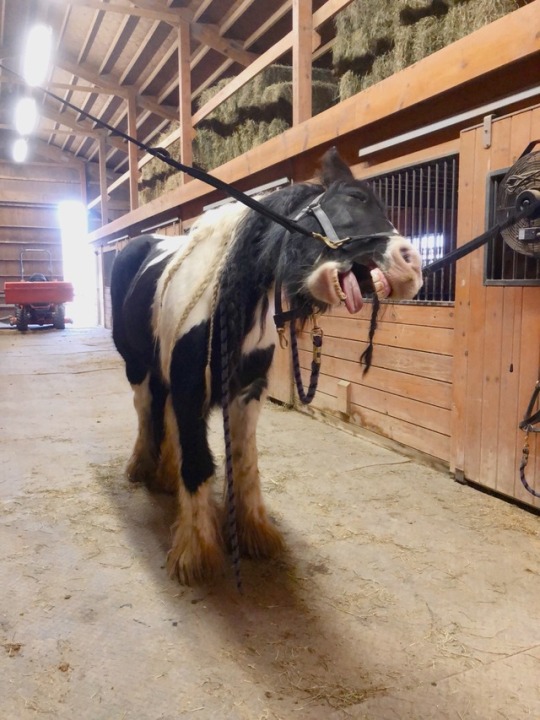
🤪
98 notes
·
View notes
Text
Fun Vanner Cob Silver Dapple
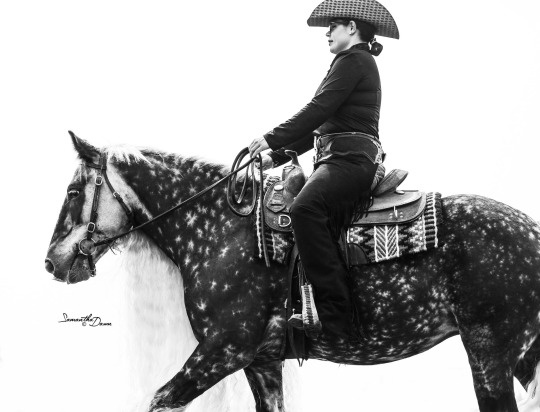






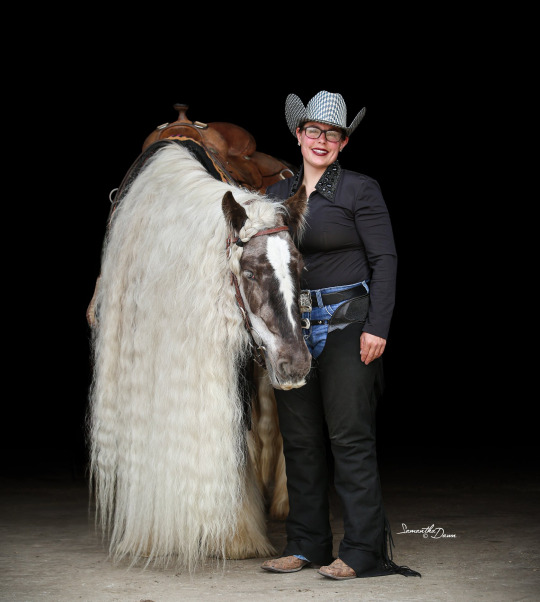
Rosie's Vogue, six year old Vanner Cob mare.
244 notes
·
View notes
Text
Horse Breed Tournament
Round 2 Group 1
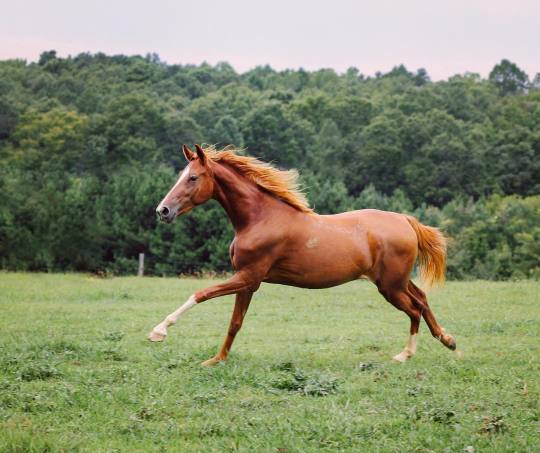
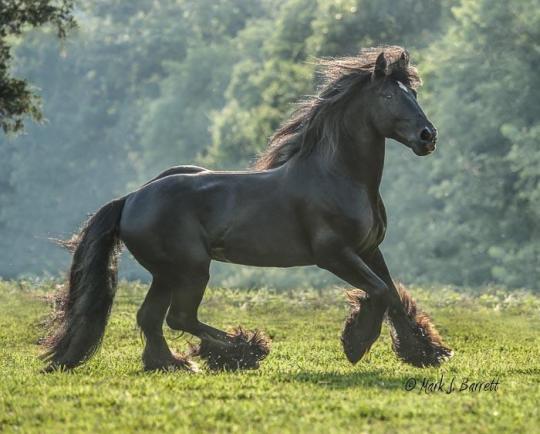
American Saddlebred Image by unconventionalequestrian (Instagram) --- Gypsy Horse Image from all-the-horses (Tumblr)
3 notes
·
View notes
Text

08/04-2021🐴
Horse: SSFR Miss Special Edition
#First Horse!!#Breed: Gypsy Vanner#Also known as#gypsy horse#tinker#or#irish cob#Origin: Great Britain#and#ireland#They're the perfect middle of shetland pony and shire! <33#F2U
71 notes
·
View notes
